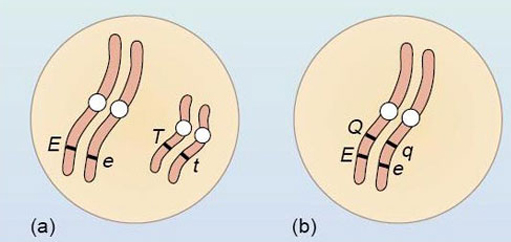5 Inheritance of more than one pair of contrasting characters
We have considered the inheritance of one pair of contrasting characters that involves the segregation of the two copies of one gene in maize. A single chromosome carries many genes, of the order of 2 000 to 4 000 in each human chromosome, each carrying its own information, and each with its specific location, its own locus, on the chromosome. In a pair of homologous chromosomes, there will be many pairs of genes strung along their length.
These observations raise some intriguing questions. What happens when a cross is made that involves two pairs of genes affecting two different characters? Are genes that are present on the same chromosome inherited together?
Activity 12
A heterozygous plant with the genotype Ee Tt produces four kinds of gametes, E T, e t, E t and e T in the ratio 1:1:1:1. Another heterozygous plant, with the genotype Ee Qq, produces four kinds of gametes, E Q, e q, E q and e Q in the ratio 8:8:1:1. How can these differences between the two ratios be explained?
Answer
In the first plant, the genes are on different pairs of homologous chromosomes — E and e on one pair and T and t on another pair, as shown in Figure 16a. This means that at gamete formation the genes assort independently from each other to give the four different gamete genotypes in equal proportions.
In the second plant, the genes must be linked on the same chromosome, as shown in Figure 16b. This means that at gamete formation E and Q, and e and q, will stay together more often than they separate. Only when the linkage is broken by crossing over will the gametes of genotypes E q and e Q be produced. As this is a relatively rare event, most of the gametes will be E Q and e q, with only a small proportion of E q and e Q; hence the 8E Q : 8 e q: 1 E q : 1 e Q ratio.

Question 17
If the genes making up the genotype of an animal were shown to be organized into five groups of linked genes, how many chromosomes would you expect to find: (a) in each gamete; (b) in each fertilized ovum?
Answer
Genes that are in the same linkage group are on the same chromosome, so you would expect to find (a) five chromosomes in each gamete and (b) ten chromosomes in each fertilized ovum.
